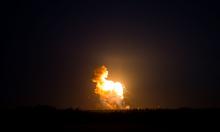Russia passes into service 4th-generation K-560 sub, combat robots come next

The first multipurpose nuclear submarine of project Yasen, K-560 Severodvinsk, joined the Navy of the Russian Federation on Tuesday. The ceremony to raise St. Andrew's flag on the fourth-generation nuclear submarine was held at the pier of military shipyard Sevmash in Severodvinsk, ITAR-TASS reports. The Commander of the Navy of the Russian Federation Viktor Chirkov took part in the ceremony.
The trial operation of the Severodvinsk submarine started on December 30, 2013, Specialists Sevmash say that this is the most modern and low-noise domestic submarine. The sub will be based in the town of Zaozersk.
Before the end of 2014, the Severodvinsk will travel to the permanent base point of the Northern Fleet, Admiral Chirkov said.
The multipurpose submarine that does not carry ballistic missile was designed by marine engineering bureau Malachite in St. Petersburg. The construction started at Sevmash on December 21, 1993. The submarine was launched only in 2010, due to a number of economic difficulties and new design features.
For example, for the first time in Russian shipbuilding, torpedo compartments are located behind the central post. This made it possible to place a large sonar antenna on the front part of the sub. Vertical missile launchers were used for missile arms. The Severodvinsk received state-of-the-art communication and navigation systems and a fundamentally new nuclear power plant. The displacement of the submarine is 9500 tons; its length is 120 meters; the maximum depth - 600 meters. The submarine develops the maximum underwater navigation speed of 57 km/h; the crew - 85 people. Before 2020, Sevmash is to build seven nuclear submarines of Yasen and Yasen-M classes armed with cruise missiles.
The main feature of Project 885 submarines is their multi-purpose use. The subs are capable of striking not only enemy ships and submarines, but also ground targets. The submarines are armed with state-of-the-art cruise missiles "Caliber" and "Onyx".
Navy Commander Victor Chirkov said that the appearance of the Severodvinsk in the navy was a significant step in the practical implementation of the plan to strengthen the capacity of the underwater navy. The admiral noted that the navy command works on design and construction questions jointly with the industry.
According to the commander, the works to design fifth-generation submarines are already underway in Russia. "Tough laws and ship-building regulations exclude pauses in the creation of new generations of submarines," he said.
"Therefore, we demand the industry should avoid interruptions and start designing the next generation of submarines as soon as the works on the previous generation ends. This is not the stage of construction, but the design phase. This is very important. With such an approach, we will avoid technology backlog and build the submarines that meet most modern requirements," said the admiral.
The capacity of the Russian underwater fleet will be enhanced with the help of combat robots, said Admiral Chirkov. "Improving combat capabilities of nuclear and non-nuclear submarines will also depend on the integration of prospective robotic systems. This is provided by the plans, and these plans will be implemented," said the commander.
In the future, Russia plans to build two groups of nuclear submarines of new generation - multi-purpose and strategic ones - on Northern and Pacific fleets. "The implementation of the long-term program of military shipbuilding enables us to accomplish the task of building the group of nuclear multi-purpose submarines of new generation on the Northern and Pacific fleets, along with the creation of the groups of new missile strategic submarines," said the admiral.
Presently, the Russian Navy has 60 submarines, ten of which are strategic nuclear subs and more than 30 of them are multipurpose nuclear subs. The rest are diesel and special purpose submarines.
The command of the Russian Navy intends to abandon the practice of decommissioning the vessels that can still be repaired and modernized. The Severodvinsk will serve to protect the borders of Russia for at least 30 years.
Pravda.Ru
Subscribe to Pravda.Ru Telegram channel, Facebook, RSS!




